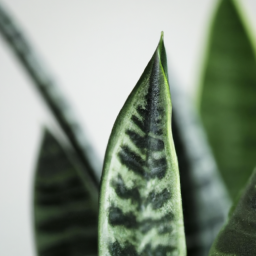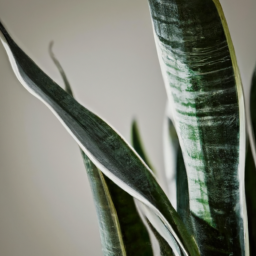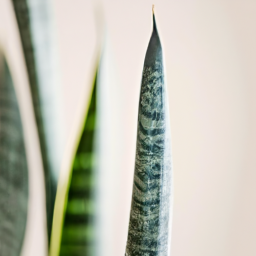
Are you looking to add some greenery to your home or office space? Snake plants are a popular choice for plant enthusiasts due to their low maintenance and air-purifying qualities. In this blog post, we will explore the different types of snake plants available, from the classic Sansevieria trifasciata to more unique varieties like the Sansevieria cylindrica. Whether you’re a seasoned plant parent or just starting out, there’s a snake plant out there for everyone. Let’s dive in and discover the beauty and diversity of these fascinating plants.
Common Varieties of Snake Plants
Sansevieria Trifasciata
When it comes to snake plants, the Sansevieria Trifasciata is one of the most popular varieties. Also known as the mother-in-law’s tongue, this plant has long, upright leaves that are variegated with shades of green and yellow. It is a hardy plant that can thrive in low light conditions and requires minimal maintenance, making it a great choice for beginners.
One of the most common cultivars of the Sansevieria Trifasciata is the ‘Laurentii’, which has yellow margins on its leaves that add a pop of color to any room. Another popular cultivar is the ‘Moonshine’, which has silvery-green leaves that give it a more modern and sleek appearance.
In addition to its aesthetic appeal, the Sansevieria Trifasciata is also known for its air-purifying properties. It can remove toxins such as formaldehyde, xylene, and toluene from the air, making it a great choice for improving indoor air quality.
Overall, the Sansevieria Trifasciata is a versatile and low-maintenance plant that can thrive in a variety of conditions, making it a great addition to any home or office space.
Sansevieria Cylindrica
Another popular variety of snake plant is the Sansevieria Cylindrica, also known as the cylindrical snake plant or spear sansevieria. This plant is characterized by its long, cylindrical leaves that grow upright and taper to a point, giving it a unique and striking appearance.
The Sansevieria Cylindrica is a drought-tolerant plant that requires infrequent watering, making it a great choice for those who tend to forget about their plants. It can thrive in bright, indirect light but can also tolerate lower light conditions, making it a versatile option for any space.
One of the most popular cultivars of the Sansevieria Cylindrica is the ‘Boncel’, which has shorter, more compact leaves that give it a more bushy appearance. Another popular cultivar is the ‘Spaghetti’, which has thinner leaves that resemble spaghetti noodles.
In addition to its unique appearance, the Sansevieria Cylindrica is also known for its air-purifying properties. It can remove toxins such as formaldehyde, benzene, and trichloroethylene from the air, making it a great choice for improving indoor air quality.
Overall, the Sansevieria Cylindrica is a visually striking and low-maintenance plant that can thrive in a variety of conditions, making it a great addition to any indoor space.
Sansevieria Hahnii
The Sansevieria Hahnii, also known as the bird’s nest sansevieria, is a compact variety of snake plant that is characterized by its rosette of short, stiff leaves. This plant is great for small spaces or as a tabletop plant, as it stays relatively small and compact compared to other varieties of snake plants.
The Sansevieria Hahnii is a low-maintenance plant that requires infrequent watering and can thrive in a variety of light conditions, from bright, indirect light to low light. It is a great choice for beginners or those who don’t have a green thumb, as it is very forgiving and can tolerate neglect.
One of the most popular cultivars of the Sansevieria Hahnii is the ‘Golden Hahnii’, which has yellow variegation on its leaves that adds a pop of color to any space. Another popular cultivar is the ‘Black Hahnii’, which has dark green leaves that give it a more modern and sleek appearance.
In addition to its compact size and unique appearance, the Sansevieria Hahnii is also known for its air-purifying properties. It can remove toxins such as formaldehyde, xylene, and toluene from the air, making it a great choice for improving indoor air quality.
Overall, the Sansevieria Hahnii is a compact, low-maintenance plant that can thrive in a variety of conditions, making it a great addition to any indoor space.

Unique Features of Different Snake Plant Species
Welcome to our guide on the unique features of different snake plant species! Snake plants, also known as Sansevieria, are popular houseplants known for their striking appearance and low maintenance requirements. In this article, we will explore some of the most unique and interesting snake plant species, highlighting their distinct characteristics and how to care for them.
Zeylanica Snake Plant
The Zeylanica snake plant is a striking variety with long, sword-shaped leaves that are dark green with light green horizontal stripes. This plant is known for its air-purifying properties, making it a great choice for indoor spaces. The Zeylanica snake plant is relatively easy to care for, requiring minimal water and indirect sunlight. It can tolerate low light conditions, making it a versatile choice for different environments.
To care for a Zeylanica snake plant, make sure to plant it in well-draining soil and water it sparingly, allowing the soil to dry out between waterings. This plant does not require frequent fertilization and can thrive in a variety of temperatures. The Zeylanica snake plant is a great choice for beginners and experienced plant enthusiasts alike.
In addition to its air-purifying properties, the Zeylanica snake plant is also known for its ability to thrive in low light conditions, making it an ideal choice for offices and other indoor spaces with limited natural light. This plant can grow up to 3 feet tall and is a great addition to any plant collection.
Black Coral Snake Plant
The Black Coral snake plant is a unique variety with dark green leaves that have a distinctive wavy texture. This plant is known for its striking appearance and is a great choice for adding a touch of drama to any indoor space. The Black Coral snake plant is relatively easy to care for, requiring minimal water and indirect sunlight.
To care for a Black Coral snake plant, make sure to plant it in well-draining soil and water it sparingly, allowing the soil to dry out between waterings. This plant does not require frequent fertilization and can thrive in a variety of temperatures. The Black Coral snake plant is a great choice for plant enthusiasts looking for a unique and eye-catching addition to their collection.
In addition to its striking appearance, the Black Coral snake plant is also known for its air-purifying properties, making it a great choice for improving indoor air quality. This plant can grow up to 2 feet tall and is a great choice for beginner and experienced plant enthusiasts alike.
Moonshine Snake Plant
The Moonshine snake plant is a popular variety with silvery-green leaves that have a subtle shimmer, giving them a moonlit appearance. This plant is known for its unique coloration and is a great choice for adding a touch of elegance to any indoor space. The Moonshine snake plant is relatively easy to care for, requiring minimal water and indirect sunlight.
To care for a Moonshine snake plant, make sure to plant it in well-draining soil and water it sparingly, allowing the soil to dry out between waterings. This plant does not require frequent fertilization and can thrive in a variety of temperatures. The Moonshine snake plant is a great choice for plant enthusiasts looking for a unique and elegant addition to their collection.
In addition to its unique coloration, the Moonshine snake plant is also known for its air-purifying properties, making it a great choice for improving indoor air quality. This plant can grow up to 2 feet tall and is a great choice for adding a touch of sophistication to any indoor space.

Care Tips for Various Types of Snake Plants
Introduction
Snake plants, also known as Sansevieria, are popular houseplants known for their easy care and air-purifying qualities. There are various types of snake plants, each with its own unique characteristics and care requirements. In this article, we will explore the different types of snake plants and provide care tips for each variety.
Types of Snake Plants
When it comes to snake plants, there are several different varieties to choose from. Some of the most common types include:
1. Sansevieria Trifasciata
Sansevieria Trifasciata, also known as the mother-in-law’s tongue, is one of the most popular snake plant varieties. It has long, sword-shaped leaves that are dark green with light green horizontal stripes. This variety is known for its air-purifying qualities and can thrive in low light conditions.
To care for Sansevieria Trifasciata, place it in a well-draining potting mix and water sparingly. Allow the soil to dry out completely between waterings to prevent root rot. This variety prefers indirect sunlight and can tolerate low light conditions.
Propagation of Sansevieria Trifasciata can be done through division or leaf cuttings. Simply cut a leaf into sections and plant them in a well-draining soil mix. Keep the soil moist until roots develop, then water sparingly as the plant grows.
2. Sansevieria Cylindrica
Sansevieria Cylindrica, also known as the cylindrical snake plant, is a unique variety with cylindrical, upright leaves. The leaves are dark green with light green variegation, giving them a striking appearance. This variety is drought-tolerant and can thrive in a variety of light conditions.
To care for Sansevieria Cylindrica, plant it in a well-draining potting mix and water sparingly. This variety prefers bright, indirect sunlight but can also tolerate low light conditions. Allow the soil to dry out completely between waterings to prevent overwatering.
Propagation of Sansevieria Cylindrica can be done through division or leaf cuttings. Simply cut a leaf into sections and plant them in a well-draining soil mix. Keep the soil moist until roots develop, then water sparingly as the plant grows.
3. Sansevieria Fernwood
Sansevieria Fernwood, also known as the fernwood snake plant, is a compact variety with narrow, upright leaves. The leaves are dark green with light green horizontal stripes, giving them a unique appearance. This variety is easy to care for and can thrive in a variety of light conditions.
To care for Sansevieria Fernwood, plant it in a well-draining potting mix and water sparingly. This variety prefers bright, indirect sunlight but can also tolerate low light conditions. Allow the soil to dry out completely between waterings to prevent overwatering.
Propagation of Sansevieria Fernwood can be done through division or leaf cuttings. Simply cut a leaf into sections and plant them in a well-draining soil mix. Keep the soil moist until roots develop, then water sparingly as the plant grows.
In conclusion, snake plants are versatile houseplants that come in a variety of shapes and sizes. By following the care tips outlined in this article, you can ensure that your snake plant thrives and adds beauty to your home. Remember to adjust your care routine based on the specific needs of the variety you choose, and enjoy watching your snake plant grow and flourish.
Let’s bring it all home
Snake plants, also known as Sansevieria, are popular houseplants known for their striking appearance and low maintenance requirements. There are several different types of snake plants, each with its own unique characteristics. One common variety is the Sansevieria trifasciata, also known as the mother-in-law’s tongue, which features long, upright leaves with green and yellow stripes. This type of snake plant is known for its air-purifying properties and ability to thrive in low light conditions, making it a great choice for beginner plant owners.
Another popular type of snake plant is the Sansevieria cylindrica, which has cylindrical leaves that grow in a tight cluster. This variety is often referred to as the cylindrical snake plant or African spear plant. With its distinctive shape and easy-care requirements, the Sansevieria cylindrica is a favorite among plant enthusiasts looking to add a touch of modern elegance to their indoor spaces. Whether you prefer the classic look of the Sansevieria trifasciata or the sleek appearance of the Sansevieria cylindrica, there is a snake plant variety to suit every taste and style.
Top FAQs:
Q1: What are the different types of snake plants?
A1: There are several varieties of snake plants, including the Sansevieria trifasciata (commonly known as the Mother-in-law’s tongue), Sansevieria cylindrica (also called the African spear plant), and Sansevieria moonshine (known for its silvery-green leaves).
Q2: How do I differentiate between the different types of snake plants?
A2: You can differentiate between snake plant varieties based on their leaf shape, color, and size. For example, the Mother-in-law’s tongue has long, sword-shaped leaves with yellow edges, while the African spear plant has cylindrical leaves that grow in a fan shape.
Q3: What are the care requirements for different types of snake plants?
A3: Snake plants are known for their low maintenance nature. They thrive in indirect sunlight and require infrequent watering. Different varieties may have slightly different care needs, so it’s best to research the specific requirements for the type of snake plant you have.
Q4: Can I mix different types of snake plants in the same pot?
A4: Yes, you can mix different types of snake plants in the same pot as long as they have similar care requirements. This can create a visually appealing display of various leaf shapes and colors.
Q5: Where can I purchase different types of snake plants?
A5: You can purchase different types of snake plants at local nurseries, garden centers, or online plant shops. Make sure to research the specific variety you’re interested in to ensure you’re getting the right type of snake plant for your collection.
Dr. Olivia Green is a botanist with over two decades of experience in indoor plant cultivation. She holds a Ph.D. in Plant Biology and has dedicated her career to researching plant behavior in controlled environments. Dr. Green is passionate about helping plant enthusiasts master the art of indoor gardening through her extensive knowledge and practical insights.


